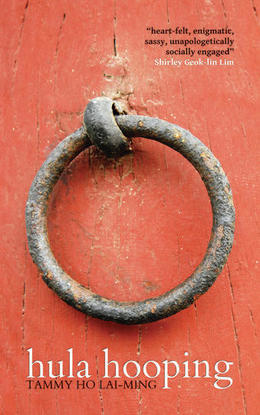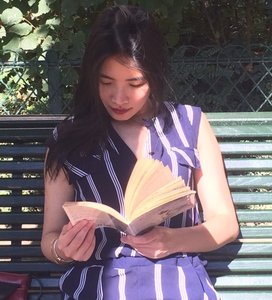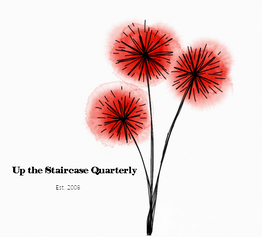
Paperback: 95 pages
Publisher: Chameleon Press (2015)
Available @ Amazon.com
Review by Margaret Stawowy
Read Margaret's interview with Tammy Ho Lai-Ming.
Hula Hooping, Hong Kong poet Tammy Ho Lai-Ming’s first collection, was fifteen years in the making. Founding co-editor of Cha: An Asian Literary Journal, Ho is a Hong Kong native who writes in British English, rendering a voice and viewpoint that feels familiar, and yet is utterly unique. From the richness of the cinnabar red cover with a weathered door pull, the reader opens into Ho’s experiences: family, friends, politics, death, life, and love.
Ho’s autobiographical poems captivate with nuanced revelations—a toothless grandmother who never learned Hong Kong Cantonese, her too young mother, struggling to cope after the birth of twins, a father who labored in construction, and what seems like a string of undeserving boyfriends that earned this comment from her mother:
Yes, some flowers attract flies.
(My mother was determined to make me see reason.)
They are foul-smelling. But you are not.
So why do you trap this fly?
You deserve bees, butterflies, birds.
I ignored her.
Love does not need to be sweet
When you are young.
Later, Ho writes of yet another questionable suitor who cycles through France with her photo laced to the wheels of his bicycle, only to be stopped by adoring young women wanting to buy the pictures. She writes with wry humor:
You are my newest boyfriend
(the hottest, the tallest, the most
London) who is now in France.
These funny, frank, personal poems are only one aspect of Ho’s oeuvre. In contrast, her political poems are chilling in their absurdity, particularly “Official causes of death in a Chinese prison” written as an abecedary:
A exhausted himself arranging sunflowers.
B drank too much water.
C suffered a heart attack passing a toilet roll to his comrades. . .
In another poem, a friend comments that “Everything seems surreal in China,” to which Ho comments that “Kafka couldn’t have dreamt it as well as the people who live it.” Surreal, as in dead baby girls washed ashore with tags bearing date of birth, weight, and mothers’ names. Or the fact that when people died in the Great Famine, you didn’t eat the dead of your own family, but traded with the neighbors. Surreal and disturbing, Ho navigates the gruesome with a deft irony that magnifies the horror.
Death and filial duty play a prominent role in Chinese culture, and in the section “To make death in us live” there is a series of poems, one revealing that the deceased have very particular material tastes, such as Gucci bags, the latest electronic devices, and Rolex watches—the paper versions, thankfully. In “The soliloquy of the paper iPod maker” Ho questions her father about the ritual of burning paper representations, because “the dead will never receive these dying ashes.” And though his reply is obscure, Ho intuits his meaning:
. . .what we do is more a
comfort to the irretrievably surviving. The most
enjoyable moment is when the eyes are choked
by the blinding smoke. . .
Ho’s style, while straightforward, captures with unpredictability and a fine sense of storytelling, not to mention mischievousness. She employs a vividness, that can be comic, mysterious, sometimes disquieting-- at times, all three.
In “Ring fingers,” the narrator wakes up with missing digits. She informs that when it happened previously, one finger was found in her vagina, the other had been chewed by the cat. Calling to mind King Missile’s song “Detachable Penis,” the narrator searches with no success. She then addresses a mysterious “you” and tells “you” that she hesitated to inform of this turn of event, that there was no reason to, as “you” had “already severed and swallowed them whole." “Ring fingers” reads like a song lyric and a conversation in one’s sleep, all at the same time.
Ho’s eponymous poem, “Hula hooping,” appears in the book’s final section “Envoi,”, which stands apart from her other poems in structure and length. Up until this point, most of Ho’s poems are one to one-and-a-half pages long, and divided into stanzas. In contrast, “Hula hooping” is a continuous, six-page poem that functions somewhere between autobiography and manifesto that propels itself forward by rapidly changing the subject. Somehow, as in a ghazal, which also jumps from subject to subject, everything hangs together by the conclusion. Ho (who, as mentioned above, is also a literary journal editor), reveals in this poem that:
“. . .the best way to annoy an editor is to not address her in an email, as though you are writing to a void and have never learned to be polite. . .”
Submitters, take note! Other quotable lines include:
“. . .My passport photos are ugly but the urgency of having them taken means that one can’t be too fussy. . .”
and
“. . .I believe in attraction only when there is a mirror in the room and we are too engrossed with our reflections in it looking back at us. . .”
So where does hula hooping fit in?:
“. . .My sisters and I believe that playing with a hula hoop will give us slim waists (it doesn’t work on everyone). A famine survivor wept before me some years ago. . .”
By placing these two sentences adjacent to each other, the reader is jolted from vanity to starvation in just a brief circle of time.
The idea of circularity reflects throughout the book, from the ring-shaped door pull on the cover, to the graphic between sections of a stylized spiral reminiscent of a nautilus shell. From book design to content, Hula Hooping is a noteworthy import that captures a distinctive voice of the new Hong Kong.
Publisher: Chameleon Press (2015)
Available @ Amazon.com
Review by Margaret Stawowy
Read Margaret's interview with Tammy Ho Lai-Ming.
Hula Hooping, Hong Kong poet Tammy Ho Lai-Ming’s first collection, was fifteen years in the making. Founding co-editor of Cha: An Asian Literary Journal, Ho is a Hong Kong native who writes in British English, rendering a voice and viewpoint that feels familiar, and yet is utterly unique. From the richness of the cinnabar red cover with a weathered door pull, the reader opens into Ho’s experiences: family, friends, politics, death, life, and love.
Ho’s autobiographical poems captivate with nuanced revelations—a toothless grandmother who never learned Hong Kong Cantonese, her too young mother, struggling to cope after the birth of twins, a father who labored in construction, and what seems like a string of undeserving boyfriends that earned this comment from her mother:
Yes, some flowers attract flies.
(My mother was determined to make me see reason.)
They are foul-smelling. But you are not.
So why do you trap this fly?
You deserve bees, butterflies, birds.
I ignored her.
Love does not need to be sweet
When you are young.
Later, Ho writes of yet another questionable suitor who cycles through France with her photo laced to the wheels of his bicycle, only to be stopped by adoring young women wanting to buy the pictures. She writes with wry humor:
You are my newest boyfriend
(the hottest, the tallest, the most
London) who is now in France.
These funny, frank, personal poems are only one aspect of Ho’s oeuvre. In contrast, her political poems are chilling in their absurdity, particularly “Official causes of death in a Chinese prison” written as an abecedary:
A exhausted himself arranging sunflowers.
B drank too much water.
C suffered a heart attack passing a toilet roll to his comrades. . .
In another poem, a friend comments that “Everything seems surreal in China,” to which Ho comments that “Kafka couldn’t have dreamt it as well as the people who live it.” Surreal, as in dead baby girls washed ashore with tags bearing date of birth, weight, and mothers’ names. Or the fact that when people died in the Great Famine, you didn’t eat the dead of your own family, but traded with the neighbors. Surreal and disturbing, Ho navigates the gruesome with a deft irony that magnifies the horror.
Death and filial duty play a prominent role in Chinese culture, and in the section “To make death in us live” there is a series of poems, one revealing that the deceased have very particular material tastes, such as Gucci bags, the latest electronic devices, and Rolex watches—the paper versions, thankfully. In “The soliloquy of the paper iPod maker” Ho questions her father about the ritual of burning paper representations, because “the dead will never receive these dying ashes.” And though his reply is obscure, Ho intuits his meaning:
. . .what we do is more a
comfort to the irretrievably surviving. The most
enjoyable moment is when the eyes are choked
by the blinding smoke. . .
Ho’s style, while straightforward, captures with unpredictability and a fine sense of storytelling, not to mention mischievousness. She employs a vividness, that can be comic, mysterious, sometimes disquieting-- at times, all three.
In “Ring fingers,” the narrator wakes up with missing digits. She informs that when it happened previously, one finger was found in her vagina, the other had been chewed by the cat. Calling to mind King Missile’s song “Detachable Penis,” the narrator searches with no success. She then addresses a mysterious “you” and tells “you” that she hesitated to inform of this turn of event, that there was no reason to, as “you” had “already severed and swallowed them whole." “Ring fingers” reads like a song lyric and a conversation in one’s sleep, all at the same time.
Ho’s eponymous poem, “Hula hooping,” appears in the book’s final section “Envoi,”, which stands apart from her other poems in structure and length. Up until this point, most of Ho’s poems are one to one-and-a-half pages long, and divided into stanzas. In contrast, “Hula hooping” is a continuous, six-page poem that functions somewhere between autobiography and manifesto that propels itself forward by rapidly changing the subject. Somehow, as in a ghazal, which also jumps from subject to subject, everything hangs together by the conclusion. Ho (who, as mentioned above, is also a literary journal editor), reveals in this poem that:
“. . .the best way to annoy an editor is to not address her in an email, as though you are writing to a void and have never learned to be polite. . .”
Submitters, take note! Other quotable lines include:
“. . .My passport photos are ugly but the urgency of having them taken means that one can’t be too fussy. . .”
and
“. . .I believe in attraction only when there is a mirror in the room and we are too engrossed with our reflections in it looking back at us. . .”
So where does hula hooping fit in?:
“. . .My sisters and I believe that playing with a hula hoop will give us slim waists (it doesn’t work on everyone). A famine survivor wept before me some years ago. . .”
By placing these two sentences adjacent to each other, the reader is jolted from vanity to starvation in just a brief circle of time.
The idea of circularity reflects throughout the book, from the ring-shaped door pull on the cover, to the graphic between sections of a stylized spiral reminiscent of a nautilus shell. From book design to content, Hula Hooping is a noteworthy import that captures a distinctive voice of the new Hong Kong.

TAMMY HO LAI-MING is a founding co-editor of Cha: An Asian Literary Journal. She has edited several volumes of poetry and short fiction published in Hong Kong, including Quixotica: Poems East of La Mancha (Chameleon, 2016), Desde Hong Kong: Poets in conversation with Octavio Paz (Chameleon, 2014), Love & Lust (Hong Kong Writers Circle / Inkstone Books, 2008) and Hong Kong U Writing: An Anthology (Department of English, University of Hong Kong, 2006). She is an Assistant Professor at Hong Kong Baptist University, where she teaches poetics, fiction and modern drama. She received the Young Artist Award in Literary Arts 2015 from the Hong Kong Arts Development Council. Her short story collection Her Name Upon The Strand will be published by Delere Press in 2016.
